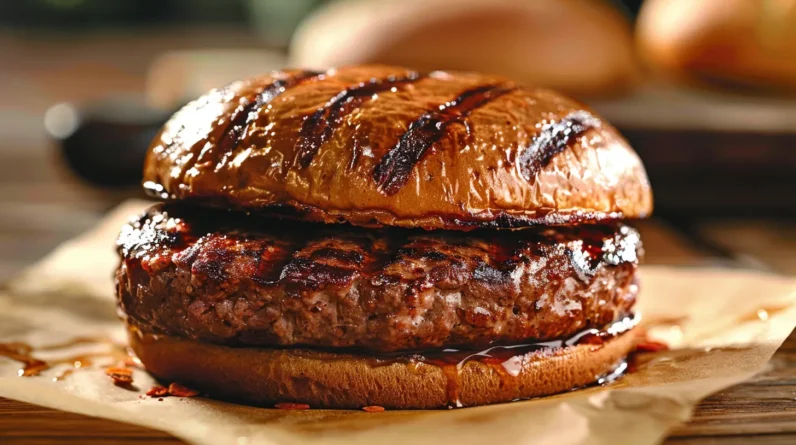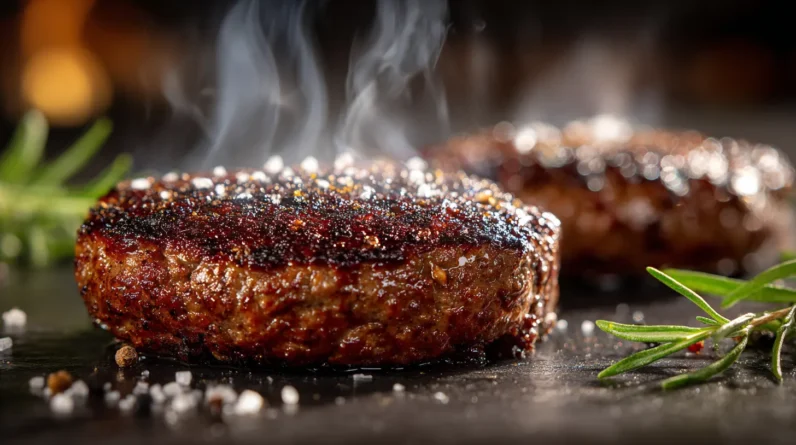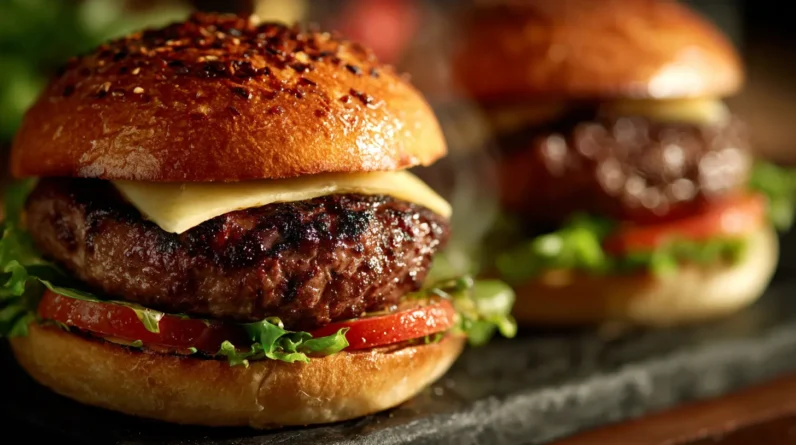
We can create delicious, healthier burgers by making smart choices at every step. Starting with an 80/20 lean-to-fat beef blend provides the perfect balance of flavor and nutrition, while mindful seasoning with kosher salt and fresh herbs enhances taste without excess sodium. Topping our burgers with nutrient-rich ingredients like caramelized onions, avocado, and microgreens adds both flavor and health benefits. Proper cooking techniques, including preheating the grill and avoiding patty-pressing, help retain moisture and prevent harmful compounds. Finishing with whole grain or sprouted buns completes a burger that’s both satisfying and wholesome. Let’s explore how each element contributes to the perfect better-for-you burger.
Choosing the Right Meat Blend
According to many burger enthusiasts, the ideal beef blend combines 80% lean meat with 20% fat content. This ratio guarantees our burgers stay juicy while cooking, yet don’t become overly greasy. We’ll want to select freshly ground chuck for its robust beef flavor and best fat distribution.
For a healthier variation, we can opt for 85/15 or even 90/10 blends, though we’ll need to adjust our cooking technique to prevent drying. When selecting our meat, let’s look for bright red coloring and avoid any packages with excessive liquid. For enhanced flavor complexity, we can request our butcher to create a custom blend incorporating brisket or short rib. Whatever ratio we choose, we’ll want to handle the meat gently when forming patties to maintain tenderness and prevent tough, dense burgers.
Smart Seasoning Strategies
The key to spectacular burgers lies in strategic seasoning timing and restraint. We’ll want to season our patties with salt just before cooking, as early salting can draw out moisture and create dense burgers. For a 6-ounce patty, we’re aiming for about ¾ teaspoon of kosher salt and ¼ teaspoon of freshly ground black pepper.
Let’s enhance flavor without overwhelming the beef by incorporating umami-rich ingredients like Worcestershire sauce or soy sauce – just ½ teaspoon per patty. For added depth, we can mix in minced garlic or shallots, but let’s keep it minimal. Fresh herbs like thyme or parsley work well, but dried herbs can burn during cooking. Remember, we’re complementing the meat’s natural flavor, not masking it.
Healthy Toppings That Pack Flavor
Once your burger is perfectly cooked, we’ll want to contemplate nutrient-rich toppings that enhance both flavor and health benefits. We’re going beyond the standard lettuce and tomato to create a powerhouse of nutrients that’ll make every bite count.
1. Caramelized onions and mushrooms: They’re packed with antioxidants and add umami depth while containing fewer calories than traditional cheese
2. Avocado slices: Rich in healthy fats and fiber, they provide a creamy texture that rivals mayo
3. Microgreens or sprouts: These deliver concentrated nutrients and a fresh crunch while adding visual appeal
4. Pickled vegetables: From carrots to jalapeños, they offer probiotics and bold flavors without excess calories
These toppings aren’t just healthy alternatives – they’re flavor enhancers that’ll transform your burger into a gourmet masterpiece.
Mindful Cooking Methods
Now that we’ve explored flavorful and nutritious toppings, let’s focus on smart cooking techniques that maximize both taste and health benefits. We’ll start by grilling our burgers on a preheated surface at medium-high heat, which creates a flavorful crust while sealing in juices. Instead of pressing down on the patties, we’ll let them cook undisturbed to retain moisture.
We can reduce fat content by using a grill rack that allows excess grease to drip away, or by placing our burgers on a broiler pan when cooking indoors. It’s essential to cook beef to 160°F (71°C) for food safety, but we’ll avoid overcooking, which can create harmful compounds. For added moisture control, we’ll let our burgers rest for 3-5 minutes before serving, allowing juices to redistribute evenly.
Better Buns and Breads
Selecting quality buns can elevate your burger from good to exceptional. We’ll explore options that balance taste with nutritional value, ensuring our burgers deliver both satisfaction and wholesome goodness.
1. Whole grain brioche buns offer a perfect compromise between indulgence and health, providing essential fiber while maintaining that buttery richness we crave.
2. Sprouted grain buns pack additional nutrients and are easier to digest than traditional wheat alternatives.
3. Lettuce wraps serve as a low-carb option that adds invigorating crunch without compromising the burger’s integrity.
4. Sourdough buns introduce beneficial probiotics and create a tangy contrast that complements beef’s savory profile.
We can also toast our buns lightly to enhance texture and prevent sogginess, creating that professional-quality finish we’re aiming for in our burger creation.
Conclusion
Making better burgers doesn’t mean sacrificing flavor for health – we’ve shown how they can coexist deliciously. From lean meat blends to vibrant toppings, smart seasoning to mindful grilling, we’re transforming this classic comfort food into a more nutritious meal. Whether we’re swapping traditional buns for wholesome alternatives or experimenting with fresh herbs, we’re proving that healthier burgers can still be the life of any backyard party.







